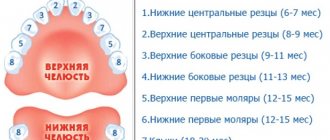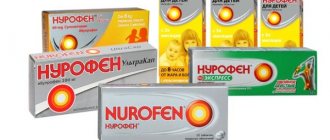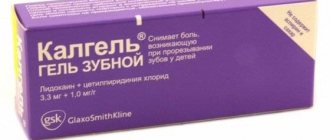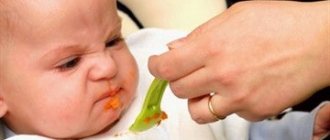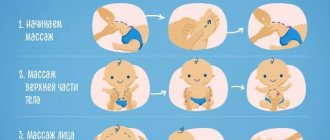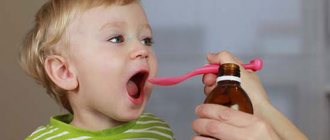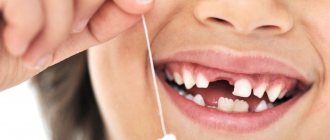Teething in children is a big event for parents. And for the baby this is a new stage in development. However, you should prepare in advance for the fact that before teething, the baby’s behavior changes greatly for the worse.
He begins to be capricious, the child’s day and night sleep patterns are disrupted, the little one whines, becomes too restless, and his appetite worsens. The baby puts his hands and various objects into his mouth to relieve pain. All this is accompanied by increased salivation, swollen gums and fever.
How to help your child survive this unpleasant period? There are several methods that can cope with discomfort and painful conditions.
Massage of sore gums during teething in children
Massage can not only reduce pain and itching, but also improve blood flow, which helps relieve the inflammatory process, help speed up teething and distract the little one from discomfort and pain. It’s not without reason that the baby puts everything he comes across into his mouth and begins to gnaw on these objects, pressing on them with his gums, in those places through which teeth will soon begin to erupt. That is why mommy should master a simple gum massage technique that will help teeth erupt faster.
You need to massage with your finger with a special attachment, which can be purchased at the pharmacy in the children's section. Before the procedure, you need to wash your hands, treat them with an antiseptic and boil the massage attachment. This is necessary in order not to introduce any infection into the baby’s oral cavity. The gums must be massaged in a circular motion from the back and front, as well as from below, in the place where teeth should erupt. The massage should last no more than a minute.
This procedure should be repeated up to seven times a day. Thanks to the special structure of the silicone “finger” attachment, it is possible to massage the gums well, improving blood circulation and reducing pain. With the help of such attachments, you can massage those gums where molars will begin to appear in the future.
to contents
rorezyvanie-zubov-u-detey-e1554707485949-160×120.jpg 160w, https://beautiful-mama.ru/wp-content/uploads/2019/04/Prorezyvanie-zubov-u-detey-e1554707485949-320×240 .jpg 320w" sizes="(max-width: 600px) 100vw, 600px" />
Teething in children: Using chewers
The use of teethers, just like massage of the gums, allows teeth to erupt faster and improves blood circulation in the oral cavity. In children's stores you can find many models of rodents, differing in material and shape. Rodents are made from wood, latex, plastic, thermoplastic rubber and silicone. Since the range of these useful gizmos is quite extensive, it is often very difficult to make a choice.
How to choose the right teethers so that they bring maximum benefit to your little one and do not injure the gums?
The most comfortable chewers are made from latex . But they have a minor drawback: they wear out too quickly, so they have to be renewed monthly. Silicone teethers are more practical, but they are much tougher than latex ones. You can purchase rodents with a special filler in the form of a gel or liquid. The teethers need to be cooled before giving them to your baby. Thus, their use will be more comfortable, since the cold relieves pain and inflammation.
You should also pay attention to the shape of the teether. You need to choose anatomical models that will not harm the mucous membranes of the oral cavity and will not spoil your toddler’s bite in the future. These useful products must clearly correspond to the age category of the child. They must be of a certain size for his age, neither large nor small.
You can even buy battery-powered chewers. Such models vibrate when the baby chews on them, providing a massage and analgesic effect on irritated gums. Children's stores sell special mittens that are put on a child's hand and he can chew on them instead of his fist.
to contents
p>
Gels and solutions
So what should you smear on your gums when teeth are cutting, what medications should you use ? There are several most popular drugs.
The first of these can be called Dentinox . The product is sold in the form of a dental gel or a solution intended for rubbing into the gums.
Indications for use: painful eruption accompanied by inflammation of soft tissues.
Use is considered acceptable for children over 3 months of age. What is the action:
- the drug has an anesthetic effect on the gum mucosa, since Lauromacrogol 400 and Lidocaine contained in it block the path of pain signals from nerve receptors to the brain, and also dulls their reaction to external stimuli;
- antiseptic and anti-inflammatory effects are achieved due to the effect of chamomile extract, which is present in the composition of the medicine;
A pea of gel on your finger or a few drops of solution on a cotton swab are rubbed into the gum of the teething tooth 2-3 times a day.
Effective implementation of the procedure involves using the drug after meals and before bedtime , in order to avoid its ingestion. The consistency of the drug allows it to stay in the gum tissue for a long time.
Possible side effects include individual intolerance to the components of the drug, which cause an allergic reaction in the child.
The drug should not be used outside the oral cavity, and especially avoid contact with the eyes.
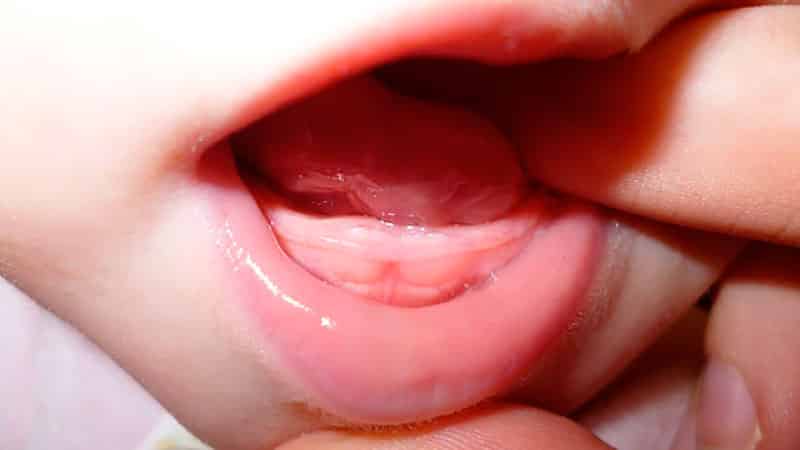
As a rule, all remedies act through local anesthesia and relief of inflammation in the gums
Another effective remedy is Kalgel . It is also sold in pharmacies in the form of a dental gel, but its use is only permissible from 5 months of age.
Indications for use are the same as in the previous case: pain during teething and concomitant inflammation of the gums. How it works:
- the drug contains Lidocaine, which locally anesthetizes the gum mucosa;
- in turn, cetylpyridinium chloride has a pronounced antiseptic effect, destroying viruses, bacteria and fungi, which contributes to the rapid disappearance of the inflammatory process in the mucous membrane.
The gel adheres well to the mucous membrane and is not absorbed into the blood. It is applied in the same way as the previous one - by rubbing it into the gum of a growing tooth.
In some cases, an allergic reaction in the form of itching, urticaria and swelling of the oral mucosa is possible. Also, Kalgel should not be used under the age of 5 months, in case of heart, kidney or liver diseases. The use of Kalgel requires prior consultation with a specialist .
The next drug on the list is called Kamistad . Like Dentinox, it is acceptable for use after 3 months of life. Indications for use are the same.
The gel contains Lidocaine to relieve pain and chamomile extract to suppress inflammation and provide an antiseptic effect.

Drugs for relieving pain during teething act quickly and the child becomes much more cheerful. The method of application is the same - rubbing the drug with massaging movements into the gums of the problem tooth 1-2 times a day. At the age of more than 2 years, the drug can be used 3 times a day.
It is recommended to strictly ensure that more than one pea of gel is not used at a time to avoid overdose.
A side effect, as in other cases, can manifest itself through an allergic reaction. The drug should not be used under the age of 3 months and in case of disease of internal organs such as the heart, kidneys and liver.
Teething in children: Traditional medicine
If the child is not allergic and is not allergic to honey, this useful product can be used to treat the baby’s gums by rubbing it into painful and swollen gums. To calm your baby down during teething, you can give him milk with a teaspoon of honey before bed.
You can use a soda solution by diluting one teaspoon of soda in 200 milliliters of water. This solution should be lubricated on the gums three times a day, using it after massage procedures or when a child uses rodents. The solution should be applied to a cotton pad and gently applied to the gums.
Chamomile has a wide range of uses. It helps to calm, relieve inflammation and pain. Pediatricians advise rubbing chamomile oil into the mucous membranes of the baby’s cheeks, and an infusion into the gums. Also, during teething, the baby can be given chamomile tea.
Many parents put amber beads on their children, noting that amber helps relieve pain and reduce inflammation in the oral cavity. The beads must be worn during the day, but must be removed at night.
You can rub valerian tincture into painful areas. It is an excellent anesthetic and reduces tearfulness and irritability of the toddler. You should use no more than seven drops of the product per procedure.
You can give your child lavender, chamomile or lemon balm tea. They are as effective as the methods described above. Also, for massage or treatment of gums after it, you can use tincture of sage, burdock, strawberry or chickweed. They relieve pain well, strengthen the tissue structures of the gums, improve blood flow and allow teeth to erupt faster.
Use cold roots and vegetables with caution. It is best to let your baby chew on teethers. And, of course, another important therapeutic component is proper and balanced nutrition for the toddler, which should contain a lot of calcium and vitamins.
to contents
00px) 100vw, 600px" />
How to help your child with teething
In their zeal to help the child, relatives often go beyond all reasonable boundaries. Many parents, to make sure that the long-awaited tooth has already appeared, try to look into the baby’s mouth almost every hour, not always remembering the necessary cleanliness of their hands. As a result of such parental impatience, the risk of various inflammatory processes in the baby’s oral cavity increases.
But an even more dangerous action of adults during this difficult period for a child is to “slip” into him, as if to relieve pain in the gums, such an alternative to special children’s teethers as food, namely:
- bread crusts;
- bagels;
- carrots;
- apple
This approach can have very disastrous consequences, especially if the child has not yet learned to eat on his own, and at the same time already has at least one tooth, or even its tip. The danger of the situation is that the baby may accidentally bite off a piece of the product and inhale it.
Experts emphasize that during the period of teething, the best help for a child is the attention and love from the parents, and of course their prudence and patient behavior.
Tokareva Larisa, pediatrician, medical columnist
Medications for teething in children
Medicines used to facilitate teething are divided into two types.
The former allow you to relieve discomfort and pain, as they contain an anesthetic and oils that have a cooling effect. And the latter relieve inflammation and improve blood flow in the gums.
If parents use gels with an analgesic effect, it is very important not to exceed the dosage indicated in the instructions. They can only be used if the pediatrician monitoring the toddler approves this drug and allows its use.
Gels with anti-inflammatory effects have a long-lasting effect, so one application is enough for about a day. They can be combined with painkillers, but only after consultation with a pediatrician.
To speed up teething, homeopathic preparations are also used. Many parents note their high effectiveness. In addition to the drugs listed above, the child may be prescribed syrups that have a complex effect, aimed at improving the general condition of the child.
Most often, children are prescribed medications presented by:
- Pansoral;
- Kagel;
- Cholisalom;
- Baby doctor;
- Dintinorm;
- Vibrocol;
- Dentokind;
- Panadol;
- Nurofen.
It should be noted that all medications can be used only after they have been approved by a pediatrician.
to contents
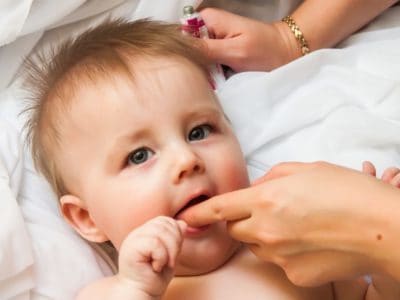
First actions
At first, it is advisable to do without any medications.
- Cool drinks and food. Helps restore water balance. Reduces itching.
- Refrigerated teethers, toys, pacifiers. A slight cold relieves the itching, and the toy itself will occupy all the baby’s attention.
- Massage of damaged mucous membranes. With light massaging movements you will scratch your gums. At first they will resist.

Baby with teether
Before using any of the proposed options, read the instructions for side effects, contraindications, and frequency of use.
Each manufacturer can change the composition, and you can only find out about this by reading the instructions.
Natural preparations
What should I put on my child’s teeth if they have erupted and hurt? The category of natural preparations is used for children under 6 months. Does not contain “vigorous” chemicals, although it may cause an allergic reaction. A simple way to check: apply the drug to your wrist. After 1.5–2 hours, check if the application site turns red - do not use this drug. The effectiveness of herbs is weaker and the duration of action is shorter, but they can be used more often.
- Baby Doctor gel for gums “First teeth”. The composition is completely natural, there is no dosage as such. Use after 3 months.
- Dantinorm baby, capsules. Frequency of use 2-3 times a day in between feedings for 3 days.
- Clove oil. Do not use oils labeled “Aromatics”, “Aromatherapy”, etc. These are extracts from oils; other than flavorings, you should not use them. Mix with flaxseed, olive, and nut oils in a 1:1 ratio.
- Valerian extract. Mix with water and soak a cotton swab for the gums, then apply to the sore spots.
- Chamomile tea. Brew tea and drink with teaspoons 3-4 times a day. Prepare compresses. You can drink tea not only when you are teething, but you can also drink it during stomatitis, as a reminiscent substance.
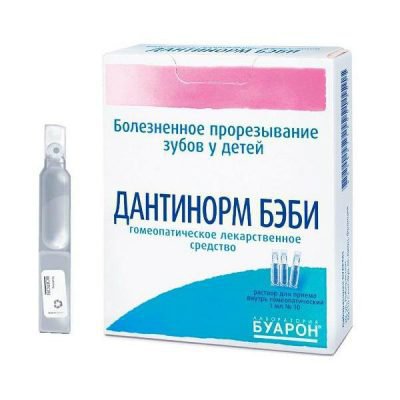
Dantinorm baby - used for painful teething
Medicines with herbal extracts
This category of medications with herbal extracts has its own dosages and side effects. Precautions: Do not swallow, do not use before feeding.
- Dentinox - Gel N. Apply 2-3 times a day with a cotton swab or clean finger, after meals. Recommended use within 2 weeks. Use from 3 months.
- Dentinox. The gel is applied to cutting teeth 2-3 times a day, with a cotton swab or a clean finger. Use from one year to one year only on the advice of a doctor.
- Bebident, solution. Frequency of application 3 times a day. Rub 1-2 drops into the gums. Recommended use within 1 week. Use from 3 months.
- Kamistad baby, gel. It is recommended to use up to three times a day. Not recommended if you have problems with the cardiovascular system. According to the instructions only from 3 months. It has antimicrobial, anti-inflammatory, analgesic and regenerating effects.
- Pansoral “First teeth”, gel. Frequency of use 3-4 times a day. Contraindications: sensitivity to aspirin and salicylic group. Use from 4 months. Has a calming and softening effect on the mucous membrane.
- Pansoral, gel. Use 1-4 times a day. Use from 2.5 years. Has an antimicrobial and analgesic effect.
Read also: How to clean a toothbrush
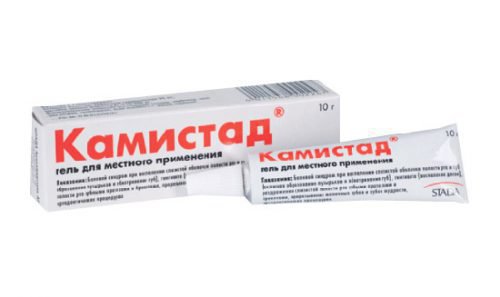
Kamistad both anesthetizes and cools
Medicines
This category includes specifically chemically produced drugs. This is more effective, but there are a number of restrictions when taking them and overdoses are possible. It is advisable to use on the advice of a doctor.
- Holisal. Frequency of use 3-4 times a day. It is recommended to use within 10 days. Recommended after one year. It has antimicrobial, anti-inflammatory and analgesic effects.
- Kalgel. You can treat your gums 6 times a day with breaks of at least 20 minutes. Contains saccharin, which is essentially sugar. Use from 6 months. Has an antiseptic and analgesic effect.
- Dentol baby 7.5%. It is allowed to smear 3-4 times a day. Recommended use within 1 week. Contains saccharin. Does not have antimicrobial effect. Use from 4 months. Has an analgesic effect.
- Dentol 10%. Frequency of use 3-4 times a day. Recommended use within 1 week. Use from six months. Has an analgesic effect.
- Leader Baby. Can be applied 6 times a day, taking at least half-hour breaks. Use from 3 months. Has an antiseptic and analgesic effect.
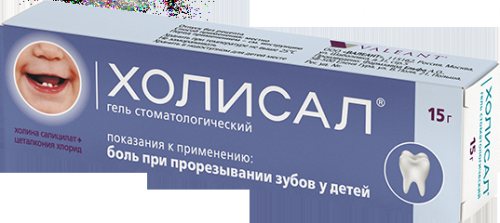
Cholisal gel for teething
All the drugs that are listed do not harm the teeth, their growth, color, shape, but only help to reduce or eliminate unpleasant sensations.
Therefore, if your baby cries tirelessly because she is in pain, you have a great opportunity to choose the appropriate option to calm your baby.
Teething in children: Distraction from discomfort
What other activities can you use to help your little one? If this is necessary, then parents need to temporarily adapt to this difficult period in the baby’s life. If, for example, mom and dad rarely take their child in their arms, then now they need to take him more often, since carrying him in his arms gives him a feeling of additional security, which allows him to feel much calmer.
During teething, you need to take more walks in nature with your child, feed not by the hour, but when the child wants it. If the toddler is breastfed and has not yet begun to wean, he needs to be breastfed more often, replacing complementary foods with it. You can add a decoction of chamomile or lavender to the water for evening bath procedures. These herbs help relieve nervous tension and discomfort associated with teething. If your baby is sucking on a pacifier, it needs to be cooled more often, this way you can help him cope with pain in his gums.
During this period, there is no need to scold the little one for putting everything that comes to his hand into his mouth. He knows that in this way the discomfort can be alleviated. You just need to pay attention to hygiene, wash your baby’s hands and all toys within his reach more often. If he wants to chew on his fist or chewers, let him use them for his health.
to contents

Gum massage during teething
Gum massage during teething
Teething can be very painful for a baby and parents are willing to try anything to relieve the pain. Gels and drops with lidocaine, anesthetic syrups, chilled water teethers and pacifiers of various shapes are used. You should definitely try gum massage, which can quickly relieve pain and allow the child to relax and, for example, fall asleep.
Massage the gums with the index finger of the left or right hand. Hands must be washed thoroughly. You should not treat them with alcohol or any other substance before touching your baby’s gums. If you do spray your hands, be sure to rinse them with cool running water.
Run your finger back and forth across the gum, applying gentle pressure to the gum. Even if your child closes his mouth at the same time, this does not threaten you in any way, and it may be more convenient for him. Continue slow movements back and forth until your baby stops fussing.
Massage can be done not only with your finger, but also with a gauze swab of a suitable size, soaked in cool boiled water. In this case, massage is done in exactly the same way as with a finger, but using a gauze pad. You can also wrap your own finger in gauze and massage it that way. Be careful and don’t put too much pressure on the baby’s gums in this case.
You can also massage your gums by wrapping your finger in a clean, damp cloth. Cool water will have an additional cooling effect, which also helps relieve pain.
This massage can be done as many times a day as needed. It is not contraindicated and has no side effects. If at the moment you do not have time to give your child a massage, then offer him a cooled water teether of a convenient shape, not too thick and small, so that the child can comfortably hold it in his hand.
You can also offer your baby a bottle with a pacifier filled with water at room temperature to soothe teething pain. Sucking movements and cool water will help relieve the condition. Tips and warnings
If you use a gauze swab or napkin, then take cold water for wetting, but if you need to fill the bottle, then the best solution is water at room temperature - the difference between the child’s body temperature and the temperature of the water in this case will be sufficient. Do not freeze water teethers; cool them only in the refrigerator or only briefly in the freezer. Ice can harm your baby.
Do not use medications containing aspirin or acetylsalicylic acid for pain relief. For children, it is safer to use drugs based on ibuprofen or acetaminophen.
Folk remedies for pain relief
For painful teething in infants, you can use medications - gels, suppositories, syrups, drops that have analgesic, anti-inflammatory and soothing properties.
Anti-inflammatory drugs
The representative of the category is Cholisal (allowed from 1 year). It does not contain lidocaine, so it does not cause numbness and can be used before meals up to 2 times a day. After application, sometimes there is a burning sensation and increased salivation.
Cooling gels
Their action is based on lidocaine: Kamistad, Kalgel, Dentinox. Apply a drop of the drug to the gum with a clean finger or a cotton swab and rub lightly into the area where the tooth is erupting. Use strictly after meals and before bedtime.
Kamistad gel is approved for use from 3 months, the number of applications is up to 3 per day. The drug relieves pain in infants, relieves inflammation, and has an antimicrobial effect due to the content of chamomile tincture.
The drug Dentinox is indicated for children from one year old, Kalgel - from 5 months.
Homeopathic gels
“Baby Doctor First Teeth” consists of herbal ingredients: calendula, echinacea, chamomile, plantain and marshmallow root. Chamomile relieves inflammation of the gums, relieves pain and acts on bacteria. Disinfectant properties are characteristic of calendula. In addition, the complex of herbs accelerates gum healing, relieves irritation of the mucous membrane, and calms the child’s nervous system.
The gel is applied to children from 3 months an unlimited number of times a day. The drug has no contraindications or side effects due to its safe, hypoallergenic composition.
Homeopathic drops
Dantinorm baby relieves teething pain when used 1 ml (dose) between feedings 3 times a day. It has no side effects, since it consists of a small amount of Indian ivy, chamomile, and rhubarb.
We suggest you read: Is it possible to drink alcohol with braces?
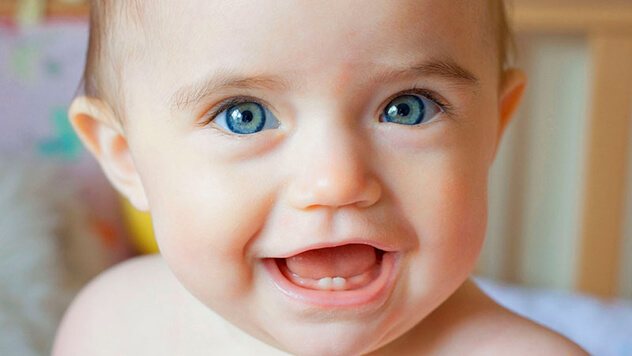
Other means
In addition to painkillers, antipyretics are used as prescribed by a doctor if the process is accompanied by an increase in temperature. For example, Panadol or Nurofen suspension, suppositories. The use of acetylsalicylic acid is contraindicated.
Cost of drugs to ease teething
| Name | Action | price, rub. |
| Holisal | Anti-inflammatory, analgesic, antiseptic | 250-340 |
| Dentinox | Anti-inflammatory, analgesic | 290-380 |
| Kamistad | Soothing, anti-inflammatory, antimicrobial, analgesic | 210-270 |
| Baby Doctor first teeth | Analgesic and anti-inflammatory | 290-360 |
| Dantinorm baby | Anti-inflammatory and analgesic | 330-380 |
Traditional medicines can also help relieve teething pain in babies.
Proven and safe methods:
- If your child is not allergic to honey, you can lubricate your gums with this product. Then rub a small amount into the painful area. To calm down, give an additional 1 tsp before bedtime. honey
- A solution of soda (tsp per 200 ml of water) can also help teething: it is used to lubricate the gums, or used to moisten massage napkins.
- Massage the infants' gums with a piece of soft cloth moistened with cool water, the main thing is not to leave it in one place.
- Chamomile has a wide spectrum of action - it soothes, relieves inflammation, and relieves pain. Chamomile oil is rubbed into the skin of the cheeks, and the infusion is rubbed into the gums. Tea is also used for mother and child.
- Amber beads worn around the child's neck during the day relieve pain and reduce swelling. It is important to remember to take them off at night.
- Valerian tincture rubbed into a painful area temporarily anesthetizes and reduces irritability, maximum 5-7 drops per application.
- Soothing tea made from chamomile, lavender, lemon balm.
No less effective and popular are tinctures of sage, chickweed or burdock for strengthening gums and relieving pain, chicory or strawberry root, terry cloth and other folk remedies. Use cold vegetables and roots with caution. It is safer to replace them with teethers.
Proper nutrition of a child is another therapeutic component during teething: the diet should contain vitamins and calcium.
There are many ways to help your baby teething. A combination of several will allow you to quickly remove inflammation and pain, forget about swelling, lack of appetite and other signs. The most effective, according to mothers, is a complex using massage, a single application of gel, and soothing tea.
Taking care of the oral cavity: how and why to massage the gums?
Every person knows how important it is to brush your teeth daily.
But not all people know that in addition to the standard oral hygiene procedure, it is necessary to massage the gums, which is no less important than brushing your teeth.
Its influence on human health has been studied for many centuries, and it has been found that it has many beneficial effects: improves health, gives strength and elasticity to muscles, prolongs youth, increases vitality, gives vigor and gives good health.
The effectiveness of massage has been scientifically proven and tested over many years of practice, and it itself is a physiological healing method.
Benefits of massage
Massaging the gums is considered the most natural and effective method of preventing periodontal disease, which can be done at home.
In addition, it has the following beneficial properties:
- eliminates stagnant processes in tissues;
- improves blood circulation;
- activates metabolic processes;
- improves nutrition of periodontal tissues;
- strengthens teeth;
- increases resistance to negative external influences;
- promotes greater supply of nutrients to tissues;
- prevents loosening of teeth and their loss;
- increases the outflow of lymph and blood;
- thickens mucous membranes, making them less vulnerable;
- eliminates swelling;
- is the prevention and treatment of periodontal disease;
- prevents inflammatory processes;
- Helps reduce bleeding gums.
Indications for massage:
Periodontitis
Bleeding gums, or periodontitis, is a common inflammatory disease of the muscle tissue surrounding the tooth.
Gum massage for periodontitis has proven itself as an effective treatment for the initial stage of the disease.
If there is bleeding, you should not use a brush or massage devices; all manipulations should be carried out with your fingers.
During the procedure, you should not press hard on the gums; movements should be smooth and slow.
For better gliding, your fingers can be lubricated with olive oil or toothpaste, and after the procedure you should rinse your mouth well with an antibacterial agent.
Periodontal disease
People suffering from periodontal disease benefit from massage to normalize blood circulation in the oral cavity; it is carried out daily at home on their own.
Additionally, it is recommended to use medicinal gels and essential oils, such as cedar or sea buckthorn.
You need to massage the gums with your fingers; you can also use an irrigator, a special device that allows you to massage more effectively.
However, before starting home treatment, you should definitely consult a specialist. Since in cases where the cause of the disease is improper growth of teeth or an incorrect bite, the help of a specialist is required.
Teeth straightening
Gum massage to straighten teeth is a therapeutic agent that is used in combination with special straightening methods.
Tactile effects on the palate and gums make the alignment procedure less uncomfortable.
Massage should be done using a toothbrush with gentle movements, as a result of which blood flow increases, which contributes to the effectiveness of the dental straightening procedure.
In order to straighten teeth, you should regularly perform a comprehensive oral massage, compiled individually by a dentist.
How and with what to massage the gums?
Massage can be performed by a dentist and is often offered to patients in conjunction with professional dental cleaning, or it can also be successfully performed independently.
The massage procedure should be performed after brushing your teeth.
You need to use the following basic movements: stroking, pressing, rubbing, squeezing.
For these purposes, you should use a soft brush with firmly attached natural bristle hairs.
You cannot use a hard toothbrush with artificial bristles; it thins the tooth enamel and injures the tissues.
There are several ways to perform a massage:
- Shtilman method. The brush should be set at an angle of 45 degrees, with the ends of the bristles on the gum and directed towards the tooth roots. You need to apply light pressure on the brush, while simultaneously moving it in different directions, so that the ends of the bristles are in soft contact with the gum.
- Finger method. Performed using the thumb and index finger. The jaw is grasped on both sides, and the fingers move from its center to the sides, movements that should repeat the physiological movements that occur during chewing of food. When massaging the lower jaw, the fingers should move from bottom to top, and the upper jaw - from top to bottom. Touches should be gentle and painless, and movements should be rotational and circular. Duration is about 5 minutes.
- Charters method. It is performed using a toothbrush; manipulations consist of vibrating circular movements, during which the side surfaces of the brush compress the gums.
- Indirect massage. It is done using fingers through the skin of the cheeks.
- Using a special silicone massager. It is especially gentle on the gums and does not injure them.
For infants, gum massage during teething is done with the index finger of the left or right hand.
The most effective method is vacuum gum massage.
The device uses vacuum tubes to help move lymph closer to the mucous membrane of the gums, stimulating local immunity.
For deeper oral care at home, use an irrigator to clean and massage the gums.
Using an irrigator, a pulsating stream of water is created, which effectively massages the gums and also cleans the intergingival spaces and areas between the teeth.
How to reduce teething pain in your baby
Pain during teething in a child occurs in 60% of cases, while in the rest the process is asymptomatic. Reduced appetite, swollen gums, drooling and the child’s desire to gnaw and bite everything can complete the picture. You can alleviate the condition with the help of massage, medications, and traditional medicine.
Before using any of the methods, it is important to exclude contraindications and, if possible, consult with a specialist.
Signs of teething
The first signs of the appearance of teeth in infants are individual in nature. Usually, all the symptoms begin to increase within a week, and as soon as the crown appears at the level of the alveolar process, the negative manifestations subside.
The initial signs are swelling or a slight increase in size of the gums. The child suddenly becomes irritable, capricious, and refuses to eat. In certain cases, increased salivation is initially observed.
The baby tries to scratch his gums, drags toys and other objects into his mouth. Specific rashes are often observed on the chest, chin and around the lips.
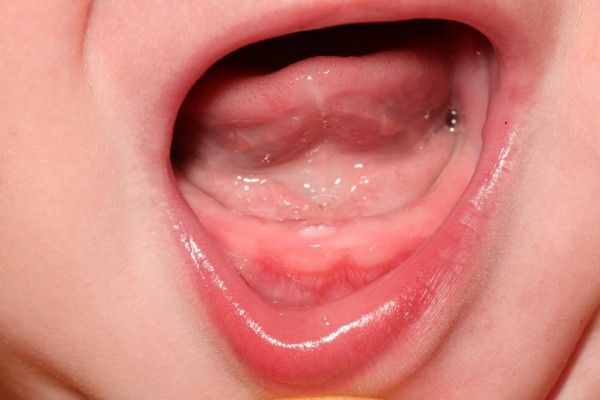
The photo shows the cutting edge of an erupted incisor of the lower jaw
In addition, classic signs of teething in babies are:
- Increased body temperature . It can reach 38 degrees. This condition is associated with the peculiarity of the body’s reactions to an unusual phenomenon occurring. If your body temperature begins to rise further, then you should think about the possibility of a viral or bacterial infection.
- Hematoma formation. Bruising forms directly in the area where teeth appear. The hematoma has a bluish tint and looks quite unpleasant. But no medical intervention is required. However, its progress should be monitored, so if an inflammatory process occurs, the hematoma has to be hidden.
- Pronounced gag reflex . It occurs in cases where the child has increased salivation. He swallows this liquid in large quantities. Vomiting itself occurs no more than twice a day.
- Diarrhea . Loose stools in a baby are also often a symptom of teething. The act of defecation should be no more than 6 times during the day. There should be no blood or mucus in the stool. If your baby's stool is too loose, there may be an intestinal infection.
- Catarrhal phenomena . Teething in a baby may be accompanied by a runny nose and cough. All catarrhal phenomena are not very pronounced. Cough and runny nose are formed due to excessive salivation. Parents should carry out cleansing procedures of the nasal passages and monitor the child’s breathing, especially at night.
By watching the video in this article, you can additionally familiarize yourself with the signs of teething in a baby.
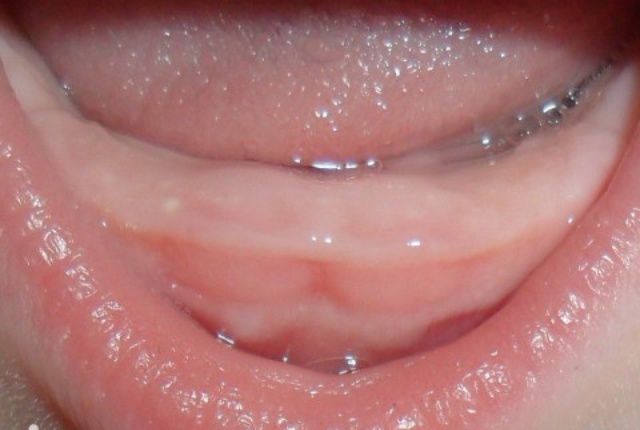
Deformation of the gums before teething in an infant
Gum massage for painful teething
This is the easiest way to relieve pain and itching in babies, improving blood circulation and speeding up teething. To carry it out, use a gauze swab, finger or a special toothbrush.
Method of massaging the gums with your finger.
- Wash your hands well, paying special attention to the area under the nails, and treat with an antiseptic.
- It is recommended to massage with the little finger, index finger or thumb exclusively above the gums, starting with stroking back and forth to the painful area. Using the same movements, gradually approach the future tooth.
- You can rub and squeeze the area. The criterion for correct execution is the child’s emotions and his condition.
- The procedure takes 15-20 minutes.
- All movements should be light and careful so as not to injure the child.
This technique is suitable for massage with a special silicone finger brush.
You can also use a piece of ice wrapped in cloth or gauze, or a swab soaked in cool water. The procedure is performed strictly in the area of the emerging tooth for no more than 5 minutes.
The advantages of this method of relieving pain in infants are the absence of contraindications, side effects, and the ability to perform an unlimited number of procedures. Spoons and pieces of food, including bread and sugar, that injure the gums are not recommended as devices for massage.
If the pain during teething is severe, a small amount of lidocaine, previously diluted with water, is used. The addition of acetylsalicylic acid is contraindicated.
Teethers that have a handle for holding and an uneven surface to eliminate itching of the gums can help with painful conditions. Cooling toys contain a gel or liquid inside that cools in the refrigerator within a few minutes. As a result of their use, the gums are cooled and pain is reduced.
Source: www.stomat-info.ru
Popular dental gels for teething
At the moment, gels for teeth and gums are presented by many companies. To make your choice easier, let's look at the most popular ones.
Dentinox
It is a transparent gel with a yellow tint and a distinct scent of mint and chamomile. Using Dentinox gel for preventive purposes allows you to achieve painless and normal formation of the first incisors, primary and subsequent molars. This drug also prevents inflammation of the oral mucosa (stomatitis), irritation of the gums and any painful sensations.
- Composition 1 g of the drug
. Active ingredients - tincture based on chamomile flowers (150 mg), polidocanol 600 (3.2 mg), lidocaine hydrochloride (3.4 mg); excipients - xylitol, carbomer (974 P), sorbitol, propylene glycol, polysorbate 20, levomenthol, purified water, sodium edetate, saccharin and hydroxide. - Side effects
. The appearance of a slight burning sensation, redness and irritation. In some cases, allergies may develop, including contact allergic reactions, itching, skin rashes and angioedema. If any of the side effects occur, stop using the product and consult a doctor. - Contraindications
. Hypersensitivity to the substances of the drug, the presence of open wounds on the mucous membrane in the oral cavity. Due to the sorbitol content, Dentinox is not recommended for the treatment of children with congenital fructose hypersensitivity.
Cholisal-Gel
Compared to cooling gels based on lidocaine, Cholisal has a pathogenetic effect aimed at getting rid of the cause of pain in this process - swelling and inflammation.
After application to the surface of the gums, the active substance of the drug, choline salicylate, is absorbed by the mucous membrane and relieves local inflammation: compression and swelling of nearby tissues are reduced, due to which the pain effect disappears. The adhesive base of the gel ensures a rapid onset of the effect (after 2-3 minutes), as well as its long-term retention, which allows Cholisal to eliminate unpleasant sensations during teething in children for up to 8 hours in one application.
- Composition per 1 g of product
. Cetalkonium chloride (100 mcg), choline salicylate (87.1 mcg); auxiliary components - anise seed oil (1.61 mg), methyl parahydroxybenzoate (1.5 mg), ethanol 96% (390 mg), hyaetellose (20 mg), glycerol (50 mg), propyl parahydroxybenzoate (0.8 mg), water (up to 1000 mg). - Side effects
. Allergy; A short-term burning sensation may occur in the area of application of the product, which can be eliminated independently. - Contraindications
. Hypersensitivity to salicylates, as well as other components of Cholisal. When treating a child under 1 year of age, caution should be exercised.
Kalgel
Designed to eliminate pain during teething in children aged 5 months and older. Calgelalidocaine, which is part of the product, helps block the excitability of the membranes of the most sensitive nerve endings, and cetylpyridinium chloride is responsible for suppressing harmful microorganisms.
- Compound
. Cetylpyridinium chloride (10 mg), lidocaine hydrochloride (33 mg); auxiliary components - xylitol, sorbitol solution 70%, glycerin, PEG-40 castor oil, ethanol 96%, xylitol, hydroxyethylcellulose 5000, laureth-9, sodium saccharin, hydrogenated concentrate, macrogol 300, vegetable flavor, levomenthol, caramel E150, purified water . - Side effects
. Allergy, as well as local irritant effect with prolonged use. - Contraindications
. The presence of hypersensitivity to the main and auxiliary substances of the drug, liver or kidney failure, bradycardia, heart failure of the II or III degree, arterial hypotension, intraventricular conduction disturbance.
Pansoral “First teeth”
The most popular herbal gels to ease teething without anesthetics. At the same time, the plant extracts included in the composition have a softening and soothing effect on the gum mucosa.
- Compound
. Extracts of marshmallow root (49.75 mg), saffron flowers (1 mg) and Roman chamomile (49.75 mg); excipients: sodium methylparaben, glycerol, sodium propylparaben, purified water, sodium saccharin, carbomer, sodium benzoate, Irish moss and triethanolamine. - Side effects.
Not identified. - Contraindications
. Newborns up to 4 months, hypersensitivity to the components of the drug.
Kamistad
Refers to the number of dental gels for small children, used at 3 months and later. Kamistad has a quick pain-relieving effect and allows you to temporarily normalize the child’s general well-being. Due to the high content of lidocaine, treatment of children under 12 years of age should be carried out only as prescribed by a pediatrician.
- Compound
. Active ingredients: tincture of chamomile flowers (protects against inflammation), lidocaine hydrochloride (anesthetic for pain relief); excipients: purified water, sodium saccharin dihydrate, benzalkonium chloride, trometamol, carbomers. - Side effects
. If you follow the recommended dosage of the gel, there are no side effects. In rare cases, a burning sensation may occur in the area where the gel is applied, as well as transient hyperemia. - Contraindications
. Hypersensitivity. Not recommended for treating infants under 3 months.
Dentol
Indicated for quick relief of pain in children from 4 months during teething. After application, Dentol begins to act after 1 minute and provides an analgesic effect for 20 minutes.
- Gel composition
.7.5%: per 1 g: benzocaine (75 mg); excipients - sodium saccharin, polyethylene glycol 8 and 75, glycerin, red dye, cherry flavor, ascorbic acid, purified water. - Side effects
. If the dosage is observed, no negative effects have been identified. There is a possibility of side effects due to individual intolerance. If swelling, itching, or hyperemia occurs in the area where the drug is applied, its further use should be discontinued. - Contraindications
. The presence of infection or multiple wounds at the site of application of the gel. Hypersensitivity to benzocaine.
Baby Doctor "First Teeth"
The product has a pinkish tint and is odorless and tasteless. Instantly eliminates inflammation and soothes gums. Regular use can significantly facilitate the process of teething without any complications, making it recommended for infants and older children.
- Compound
. Calendula (5.8%), chamomile (5%), water (70%), echinacea (5%), methylparaben (0.2%), marshmallow root (5%), plantain (5%), methylcellulose (4 %). - Side effects
. When using the drug in recommended doses and according to indications, there are no side effects. - Contraindications
. Hypersensitivity to herbal components of the medicinal product.
Why do teeth sometimes grow crooked?
Naturally smooth and beautiful teeth are not very common. For what reason does it begin to grow crookedly? Is it possible to avoid this? Such problems “come from childhood.” Among the factors that lead to a smile becoming crooked and far from ideal are the following:
- heredity - if the parents have uneven teeth, then the likelihood that the child will grow crooked and will need to be straightened is very high;
- deficiency of minerals in the mother’s diet during pregnancy – multivitamins and calcium are especially important;
- a tendency to constantly keep something in the mouth - the child’s habit of sucking a finger or a pacifier seems harmless, but often subsequently leads to the need to straighten the teeth;
- improper development of the jaws due to low load - in order for the chewing apparatus to develop harmoniously, it is not enough to give the child only liquid soups, porridges and purees, it is important to promptly introduce solid foods to the menu, and until then give the baby a teether;
- chronic respiratory diseases or frequent colds;
- early loss of baby teeth (for example, due to the development of caries).
Some parents suggest that their child's crooked teeth may straighten out on their own over time. Without a doubt, this is far from the case. If there is a problem with the bite, it will not disappear on its own, but will only progress. One more nuance - an ideal row of baby teeth does not guarantee that the permanent ones will also be straight, and a violation of the temporary bite always leads to problems with the permanent ones.
The causes of crooked teeth in a child can be varied. But very often doctors cannot determine exactly what exactly contributed to the deformation of the teeth.
There are the following probable causes of crooked teeth in a child:
- When breastfeeding, a baby does not strain to get milk. In this case, there will be no stimulation of tooth growth, which may contribute to improper tooth growth.
- Common habits in children: sucking a pacifier, fingers, pencil, lip biting. By about two years of age, the habit of sucking disappears, but in other cases it can drag on. And by this time it is necessary for the child to wean himself off the pacifier and gradually move on to solid food, which allows him to bite off and also chew it. Solid food helps the baby teeth wear down and the first teeth form correctly. These habits in children can lead to the jaws not closing, which will lead to a lengthening of the upper part of the jaw relative to the lower.
- Genetic inheritance. Of course, if one of the parents or relatives had crooked teeth, then it is likely that the child may have crooked teeth.
- Premature loss of baby teeth can lead to displacement of the dentition, which contributes to malocclusion. Therefore, baby teeth should be treated and given due attention.
- Diseases of the musculoskeletal system, as well as rickets. As you know, teeth are the same bones, so disruption of the support system also affects the teeth.
- Unhealthy habits of a mother during pregnancy, which include:
- smoking;
- alcohol;
- stress;
- abuse of products containing carcinogenic substances;
- inhalation of air with various types of chemical impurities.
- Chronic diseases.
- Features of metabolism.
Straightening teeth in children
Teeth straightening in children is always quick and effective, since in childhood, the jaw system is still mobile and elastic, which allows its position to be adjusted. The most common and effective method of straightening teeth in children is the use of a trainer, and not a brace system, as many people mistakenly believe. A trainer is a silicone mouthguard that must be placed on your teeth at night. But at night, the trainer should be worn for no longer than one hour. This method is especially effective in children who have not yet reached eight years of age.
Another effective method for straightening children's teeth is the use of straightening plates. Plates are removable devices that are made of plastic, but they have a metal frame. The plates must be worn on the teeth for 12 hours every day. Plates work best when straightening teeth in children aged seven to twelve years.
Please note that it is much easier for children to straighten their teeth than for adults. Because at a young age, bone tissue is pliable and plastic, and teeth are more pliable. You can correct your bite and straighten your teeth without using braces; the main thing is to seek medical help from a dentist in a timely manner.
Dentists say that the bite in childhood can change as permanent teeth grow to replace baby teeth. Curvature of the dentition, which occurs quite often in children, is successfully corrected by doctors.
It must be borne in mind that orthodontic correction of the dentition and bite in children with braces makes sense after the process of formation of the roots of permanent teeth is completed - at 12-14 years of age. For younger children, it is usually recommended to use trainers and plates. As well as children's mouth guards for straightening teeth.
Comfortable and lightweight children's mouth guards can successfully solve the problems of unevenly growing teeth. The principle of their operation and effectiveness are the same as those of mouthguards for adults, but a child only needs to wear them 2-3 hours a day - during the daytime.
Parents should know that for children, all mouth guards for straightening teeth are made individually - in dental clinics.
You can show your child to an orthodontist for the first time at 3 years old. This will help to timely diagnose the formation of malocclusion and take the necessary measures to correct it. And malocclusion can develop even from such seemingly harmless habits as sucking the lower lip or thumb.
But visiting a doctor does not mean that orthodontic treatment will be prescribed immediately. This will be decided by the doctor himself, based on the individual situation.
Methods for correcting malocclusion in children can be non-hardware, hardware (orthodontic), surgical and complex.
In addition to aesthetic indications for aligning and straightening permanent teeth, there are also those that directly affect the health of our body. Thus, abnormal bite and crooked teeth provoke accelerated destruction of teeth, serious gum disease and the development of caries. All this happens due to improper distribution of the load on the jaw. In addition, malocclusion and crooked teeth provoke diseases in the oral cavity, the development of which can affect the state of the digestive, cardiovascular and nervous systems.
It is best to correct the bite and the direction of tooth growth in childhood, because the dental tissue has not yet hardened. A timely solution to a child’s problem will help avoid the formation of diction defects. In addition, children's teeth can be straightened faster than an adult's. However, there is no need to despair, even if the patient is well over 25, because dentistry currently offers a wide range of effective types of therapy that can make teeth straight.
Most new parents ask a completely natural question: how can I relieve pain when my baby is teething? It’s quite difficult to answer right away. First, you need to understand what teething is and why does the baby experience pain?
Teething, as a rule, causes concern for everyone: both the baby and his parents. The child cries, becomes capricious, may wake up at night, and does not eat well.
Parents often wonder if it is possible to somehow facilitate the natural process of teething.
To make it easier for both parents and the baby himself, it is necessary to adhere to certain rules during teething.
The main one of these rules is to follow all the instructions of the child’s attending physician, pediatrician. If painful symptoms do not decrease, but only increase, you should tell your doctor about this at your appointment.
The doctor will examine the baby and prescribe special medications to reduce pain, inflammation and discomfort.
It is necessary to carefully follow the instructions, because for medicines used in pediatric practice, not only effectiveness, but also safety for the child is important.
The procedure must be approached with full knowledge of how to do it, how to prepare and how to teach the child not to worry during the procedure.
In general, gum massage during teething can be divided into several stages:
- Preparation for the event.
- Direct massage.
- Hygiene after massage.
Pregnancy, children
Source: zubiki.top
Relief products
This type of medication should not be used unnecessarily. Herbal components act on the entire body of the newborn, reducing the manifestations of teething.
Anesthesia
Dentinorm drops have a good effect during teething in children.
Usually used 1-2 times during the day, gently rubbed into the baby’s gums. Before use, a mandatory consultation with a doctor is required. You can get by with a simple circular massage of the gums using gauze or a special fingertip with massage fibers. Teethers containing a gel inside, which, when cooled in the refrigerator, perfectly relieves inflammation and is pleasant to use, have also proven themselves to be excellent. All types of medications used to relieve unpleasant symptoms and pain during teething in children are conventionally divided into three groups:
- Preparations in the form of drops for internal or local use for toothache;
- Homeopathic medicines;
- Local anesthetics (gel, ointment, cream).
Drops for pain relief
Special drops are used for teething in children. Most popular:
- “Fenistil Drops” are good for relieving swelling of the gums, as well as the nasal mucosa. Significantly relieves symptoms of teething. Used by instillation no more than 3 times a day.
- "Parlazin" is a remedy against allergic manifestations. Drops are used for teeth with more severe symptoms during eruption. They have a fairly long-lasting effect, applied once a day.
- "Dantinorm Baby Drops" is a homeopathic remedy. The components included in the drops quickly remove unpleasant symptoms during the teething period. They have proven themselves to be the best toothache drops used for children. Course use is recommended – 3 days 2-3 times a day. Such drops can completely relieve the symptoms of inflammation during toothache.
Gel for baby teeth
Some of the most effective drugs for children:
- "Kalgel" is a local anesthetic with an antimicrobial effect. It has been widely used to relieve pain; it is used in children over 5 months of age; it can be applied 5-6 times a day.
- “Kamistad-gel” – thanks to the chamomile included in the composition, it intensively fights inflammation and wounds on the gingival surface. Do not use on children under 3 months of age. The gel is applied to the gums no more than 3 times a day;
- “Dentinox” is a local anesthetic containing lidocaine and chamomile infusion, which provides noticeable pain relief as well as a therapeutic effect;
Important! Do not use the drug without a doctor's prescription.
- “Gel Cholisal” is the most popular gel with an antimicrobial and anti-inflammatory effect. Used up to 3 times a day, regardless of meals.
- "Gel Baby Doctor" - created on the basis of exclusively natural herbs, is able to quickly relieve pain and significantly reduce the inflammatory process. Prescribed only by a doctor, for children over 3 months. Relieves any signs of teething.
